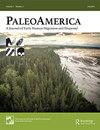阿根廷东坦迪利亚山脉更新世/全新世过渡的旱生森林记录及早期人类对木材资源的利用
IF 1.7
Q1 ANTHROPOLOGY
引用次数: 5
摘要
本文分析了阿根廷布宜诺斯艾利斯省坦迪利亚山脉东部更新世/全新世过渡时期(9032±30 - 10672±56放射性碳年以前)考古遗址的木炭记录。在更新世/全新世过渡时期发现的考古木炭有Celtis ehrenbergiana、Salix humboldtiana、Schinus sp、Colletia sp、Baccharis sp和Senecio sp。木炭具有高热值和长可燃时间,是一种很好的热源,可能被狩猎采采者用于加热、烹饪和照明。根据在更新世/全新世过渡时期的四个考古遗址中发现的C. ehrenbergiana的记录推断,至少从大约1万年前的放射性碳年开始,在坦蒂利亚山脉东部就存在旱生森林。在此期间,植被在寒冷干旱至半干旱气候下发育。本文章由计算机程序翻译,如有差异,请以英文原文为准。
Xerophytic Forest Record of the Pleistocene/Holocene Transition and Use of Wood Resources by Early Human Groups in the Eastern Tandilia Range, Argentina
ABSTRACT This contribution analyzes the charcoal records found in archaeological sites dating to the Pleistocene/Holocene transition (9032 ± 30 - 10,672 ± 56 radiocarbon years ago) located in the eastern Tandilia Range, Buenos Aires province, Argentina. The archaeological charcoal identified for the Pleistocene/Holocene transition were Celtis ehrenbergiana, Salix humboldtiana, Schinus sp., Colletia sp., Baccharis sp., and Senecio sp. Charcoals with high caloric values and long combustible duration were an excellent source of heat and were probably used by hunter-gatherers for heating, cooking, and lighting. The presence of xerophytic forests at least from ca. 10,000 radiocarbon years ago in the eastern Tandilia Range were inferred by the record of C. ehrenbergiana found in four archaeological sites during the Pleistocene/Holocene transition. During this period, vegetation developed under a cold arid to semi-arid climate.
求助全文
通过发布文献求助,成功后即可免费获取论文全文。
去求助
来源期刊

PaleoAmerica
Earth and Planetary Sciences-Paleontology
CiteScore
3.70
自引率
0.00%
发文量
15
期刊介绍:
PaleoAmerica disseminates new research results and ideas about early human dispersal and migrations, with a particular focus on the Americas. It fosters an interdisciplinary dialog between archaeologists, geneticists and other scientists investigating the dispersal of modern humans during the late Pleistocene. The journal has three goals: First and foremost, the journal is a vehicle for the presentation of new research results. Second, it includes editorials on special topics written by leaders in the field. Third, the journal solicits essays covering current debates in the field, the state of research in relevant disciplines, and summaries of new research findings in a particular region, for example Beringia, the Eastern Seaboard or the Southern Cone of South America. Although the journal’s focus is the peopling of the Americas, editorials and research essays also highlight the investigation of early human colonization of empty lands in other areas of the world. As techniques are developing so rapidly, work in other regions can be very relevant to the Americas, so the journal will publish research relating to other regions which has relevance to research on the Americas.
 求助内容:
求助内容: 应助结果提醒方式:
应助结果提醒方式:


